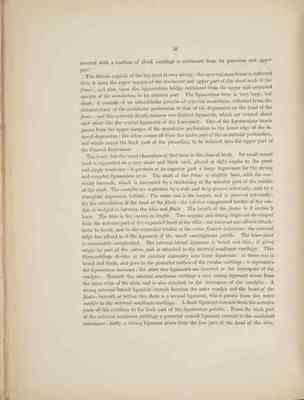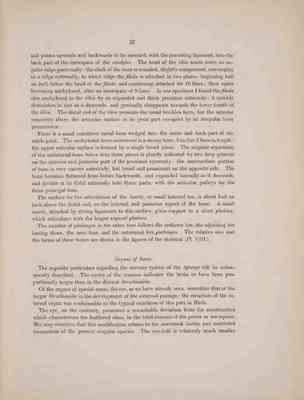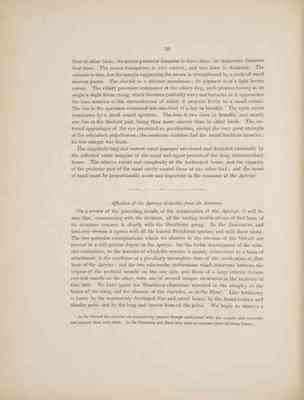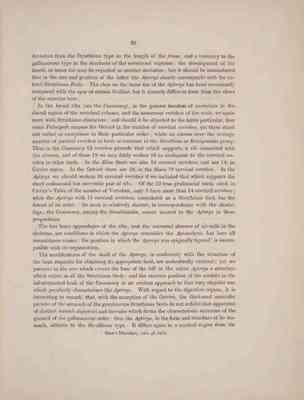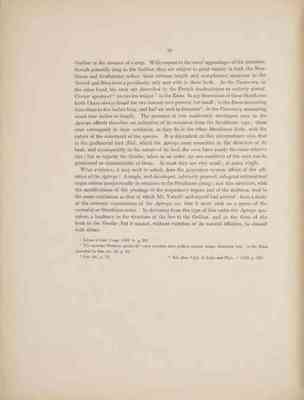Pages
56
36
covered with a cushion of thick cartilage is continued from its posterior and upper part.
The fibrous capsule of the hip-joint is very strong ; the synovial membrane is reflected from it upon the upper margin of the trochanter and upper part of the short neck of the femur ; and also upon the ligamentous bridge continued from the upper and extended margin of the acetubulum, to its anterior part. The ligamentum teres is very large, but short ; it consists of an infundibular process of synovial membrane, reflected from the circumference of the acetabular perforation to that of the depression on the head of the femur ; and this synovial sheath incloses two distinct ligaments, which are twisted about each other like the crucial ligaments of the knee-joint. One of the ligamentous bands passes from the upper margin of the acetabular perforation to the lower edge of the femoral depression ; the other comes off from the under part of the acetabular perforation, and winds round the back part of the preceding, to be inserted into the upper part of the femoral depression.
The femur has the usual characters of that bone in the class of birds. Its small round head is supported on a very short and thick neck, placed at right angles to the great and single trochanter : it presents at its superior part a large depression for the strong and complex ligamentum teres. The shaft of the femur is slightly bent, with the convexity forwards, which is increased by a thickening at the anterior part of the middle of the shaft. The condyles are separated by a wide and deep groove anteriorly, and by a triangular depression behind. The outer one is the largest, and is grooved externally, for the articulation of the head of the fibula : the inferior compressed border of the condyle is wedged in between the tibia and fibula. the length of the femur is 3 inches 9 lines. the tibia is five inches in length. Two angular and strong ridges are developed from the anterior part of the expanded head of the tibia ; the external one affords attachment to fascia, and to the expanded tendon of the rectus femoris latissimus : the internal ridge has affixed to it the ligament of the small cartilaginous putella. The knee-joint is remarkably complicated. The internal lateral ligament is broad and thin ; it gives origin to part of the soleus, and is attached to the internal semilunar cartilage. This fibro-cartilage divides at its anterior extremity into three ligaments : of these one is broad and thick, and goes to the posterior surface of the rotular cartilage ; it represents the ligamentum mucosum ; the other two ligaments are inserted at the interspace of the condyles. Beneath the internal semilunar cartilage a very strong ligament arises from the inner edge of the tibia, and is also attached to the interspace of the condyles. A strong external lateral ligament extends between the outer condyle and the head of the fibula : beneath or within this there is a second ligament, which passes from the outer condyle to the external semilunar cartilage. A thick ligament extends from the anterior parts of this cartilage to the back part of the ligamentum patelloe. From the back part of the external semilunar cartilage a posterior crucial ligament extends to the condyloid interspace ; lastly, a strong ligament arises from the fore part of the head of the tibia,
57
37
and passes upwards and backwards to be inserted, with the preceding ligament, into the back part of the inerspace of the condyles. The head of the tibia sends down an angular ridge posteriorly : the shaft of the bone is rounded, slightly compressed, converging to a ridge externally , to which ridge the fibula is attached in two places, beginning half an inch below the head of the fibula, and continuing attached for 10 lines ; then again becoming anchylosed, after an interspace of 9 lines. In one specimen I found the fibula also anchylosed to the tibia by its expanded and thick proximal extermity : it quickly diminishes in size as it descends, and gradually disappears towards the lower fourth of the tibia. The distal end of the tibia presents the usual trochlea form, but the anterior concavity above the articular surface is in great part occupied by an irregular bony prominence.
There is a small cuneiform tarsal bone wedged into the outer and back part of the ankle-joint. The anchylosed tarso-metatarsal is a strong bone, 2 inches 3 lines in length ; the upper articular surface is formed by a single broad piece. The original separation of the metatarsal bone below into three pieces is plainly indicated by two deep grooves on the anterior and posterior part of the proximal extremity : the intermediate portion of bone is very narrow anteriorly, but broad and prominent on the opposite side. The bone becomes flattened from before backwards, and expanded laterally as it descends, and divides at its distal extremity into three parts, with the articular pulleys for the three principal toes.
The surface for the articulation of the fourth, or small internal toe, is about half an inch above the distal end, on the internal and posterior aspect of the bone. A small ossicle, attached by strong ligaments to this surface, gives support to a short phalanx, which articulates with the longer ungueal phalanx.
The number of phalanges in the other toes follows the ordinary law, the adjoining toe having three, the next four, and the outermost five phalanges. The relative size and the forms of these bones are shown in the figures of the skeleton. (Pl. VII.)
Organs of Sense.
The requisite particulars regarding the nervous system of the Apteryx will be subsequently described. The cavity of the cranium indicates the brain to have been proportionally larger than in the diurnal Struthionidoe.
Of the organs of the special sense, the ear, as we have already seen, resembles that of the larger Struthionidoe in the development of the external passage : the structure of the internal organ was conformable to the typical condition of this part in Birds.
The eye, on the contrary, presented a remarkable deviation from the construction which characterizes the feathered class, in the total absence of the pecten or marsupium. We may conceive that this modification relates to the nocturnal habits and restricted locomotion of the present singular species. The eye-ball is relatively much smaller
58
38
than in other birds; its antero-posterior diameter is three lines ; its tranverse diameter four lines. The cornea transparens is very convex, and two lines in diameter. The sclerotic is thin, but the margin supporting the cornea is strengthened by a circle of small osseous plates. The choroid is a delicate membrane ; its pigment is of a light brown colour. The ciliary processes commence at the ciliary ring, each process having at its origin a slight linear rising, which becomes gradually wavy and tortuous as it approaches the lens, anterior to the circumference of which it projects freely to a small extent. The iris in the specimen examined was one-third of a line in breadth. The optic nerve terminates by a small round aperture. The lens is two lines in breadth, and nearly one line at the thickest part, being thus more convex than in other birds. The external appendages of the eye presented no peculiarities, except the very great strength of the orbicularis palpebrarum ; the membrana nictitans had the usual trochlear muscles : its free margin was black.
The singularly long and narrow nasal passages are closed and defended externally by the inflected outer margins of the nasal and upper process of the long intermaxillary bones. The relative extent and complexity of the turbinated bones, and the capacity of the posterior part of the nasal cavity exceed those of any other bird ; and the sense of smell must be proportionally acute and important in the economy of the Apteryx.
Affinities of the Apteryx deducible from its Anatomy.
On a review of the preceding details of the organization of the Apteryx, it will be seen that, commencing with the skeleton, all the leading modifications of that basis of its structure connect it closely with the Struthious group. In the diminutive and keel-less sternum it agrees with all the known Struthious species, and with these alone. The two posterior emarginations which we observe in the sternum of the Ostrich are present in a still greater degree in the Apteryx ; but the feeble development of the anterior extermities, to the muscles of which the sternum is mainly subservient as a basis of attachment, is the condition of a peculiarly incomplete state of the ossification of that bone of the Apteryx ; and the two subcircular perforations which intervene between the origins of the pectoral muscle on the one side, and those of a large inferior dermocervical on the other, form one of several unique structures in the anatomy of this bird. We have again the Struthious characters repeated in the atrophy of the bones of the wing, and the absence of the clavicles, as in the Rhea 1. Like testimony is borne by the expansively developed iliac and sacral bones, by the broad ischium and slender pubis, and by the long and narrow form of the pelvis. We begin to observe a
1 In the Ostrich the clavicles are undoubtedly present though anchylosed with the scapula and coracoids, and separate from each other. In the Cassowary and Emeu they exist as separate short styliform bones.
59
39
deviation from the Struthious type in the l of the femur, and a tendency to the gallinaceous type in the shortness of the metatarsal segment : the development of the fourth or inner toe may be regarded as another deviation ; but it should be remembered that in the size and position of the latter the Apteryx closely corresponds with the extinct Struthious Dodo. The claw on the inner toe of the Apteryx has been erroneously compared with the spur of certain Gallinoe, but it scarcely differs in form from the claws of the anterior toes.
In the broad ribs ( see the Cassowary), in the general freedom of anchylosis in the dorsal region of the vertebral column, and the numerous vertebrae of the neck, we again meet with Struthious characters ; and should it be objccted to the latter particular, that some Palmipeds surpass the Ostrich in the number of cervical vertebrae, yet these stand out rather as exceptions in their particular order, while an excess over the average number of cervical vertebrae in birds is constant in the Struthious or Brevipennate group. Thus in the Cassowary 19 vertebrae precede that which supports a rib connected with the sternum, and of these 19 we may fairly reckon 16 as analogous to the cervical vertebrae in other birds. In the Rhea there are also 16 cervical vertebrae, and not 14, as Cuvier states. In the Ostrich there are 18, in the Emeu 19 cervical vertebrae. In the Apteryx we should reckon 16 cervical vertebrae if we included that which supports the short rudimental but moveable pair of ribs. Of the 22 true grallatorial birds cited in Cuvier's Table of the number of Vertebrae, only 9 have more than 14 cervical vertebrae ; while the Apteryx with 15 cervical vertebrae, considered as a Struthious bird, has the fewest of its order. Its neck is relatively shorter, in correspondence with the shorter legs ; the Cassowary, among the Struthionidoe, comes nearest to the Apteryx in these proportions.
The free bony appendages of the ribs, and the universal absence of air-cells in the skeleton, are conditions in which the Apteryx resembles the Aptenodytes, but here all resemblance ceases : the position in which the Apteryx was originally figured 1 is incompatible with its organization.
The modifications of the skull of the Apteryx, in conformity with the structure of the beak requisite for obtaining its appropriate food, are undoubtedly extreme ; yet we perceive in the cere which covers the base of the bill in the entire Apteryx a structure which exists in all the Struthious birds ; and the anterior position of the nostrils in the subattenuated beak of the Cassowary is an evident approach to that very singular one which peculiarly characterizes the Apteryx. With regard to the digestive organs, it is interesting to remark, that, with the exception of the Ostrich, the thickened muscular parietes of the stomach of the granivorous Struthious birds do not exhibit that apparatus of distinct musculi digastrici and laterales which forms the characteristic structure of the gizzard of the gallinaceous order : thus the Apteryx, in the form and structure of its stomach, adheres to the Struthious type. It differs again in a marked degree from the
1 Shaw's Miscellany, xxiv. pl.1075.
60
40
Gallinoe in the absence of a crop. With repect to the caecal appendages of the intestine, though generally long in the Gallinoe, they are subject to great variety in both the Struthious and Grallatorial orders : their extreme length and complicated structure in the Ostrich and Rhea form a peculiarity only met with in these birds. In the Cassowary, on the other hand, the caeca are described by the French academicians as entirely absent. Cuvier 1 speaks of "un caecum unique " in the Emeu. In my dissections of the Struthious birds I have always found the two normal caeca present, but small ; in the Emeu measuring from three to five inches long, and half an inch in diameter 2 ; in the Cassowary measuring about four inches in length. The presence of two moderately developed caeca in the Apteryx affords therefore no indication of its recession from the Struthious type : these caeca correspond in their condition, as they do in the other Struthious birds, with the nature of the nutriment of the species. It is dependent on this circumstance also, that in the grallatorial (Ibis ), which the Apteryx most resembles in the structure of its beak, and consequently in the nature of its food, the caeca have nearly the same relative size ; but as regards the Grallae, taken as an order, no one condition of the caeca can be predicated as characteristic of them. In most they are very small ; in many single.
What evidence, it may next be asked, does the generative system afford of the affinities of the Apteryx ? A single, well-developed, inferiorly grooved, subspiral intromittent organ attests unequivocally its relation to the Struthious group ; and this structure, with the modifications of the plumage of the respiratory organs and of the skeleton, lead to the same conclusion as that at which Mr. Yarrell 3 and myself had arrived 4, from a study of the external organization of the Apteryx, viz. that it must rank as a genus of the cursorial or Struthious order. In deviating from the type of this order the Apteryx manifests a tendencey in the structure of the feet to the Gallinae, and in the form of the beak to the Gralloe ; but it cannot, without violation of its natural affinities, be classed with either.
1. Lecons d'Anat. Comp. 1836. iv. p. 291. 2 The accurate Fremery speaks of "caeca intestina duos pollices tantum longa, dimidium lata, " in the Emeu dissected by him, loc.cit. p. 76 3. Loc. cit., p. 72. 4. Art. Aves, Cycl. of Anat. and Ohys., i. 1836, p.269.
